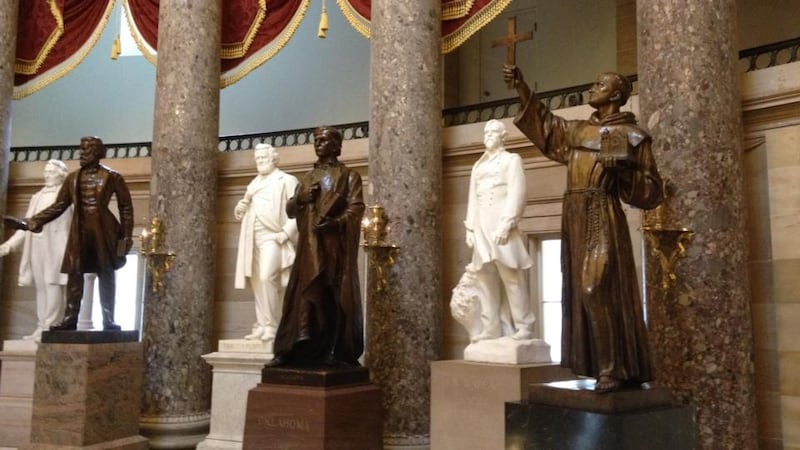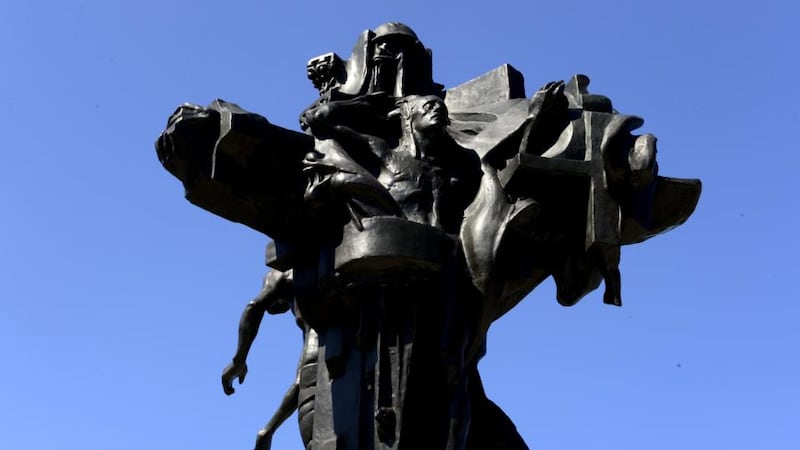With American politics having taken on some of the the characteristics of a soap opera, we’re accustomed to seeing US politicians on our television screens in various stages of embarrassment, outrage and general disarray.
These brief interviews are often conducted against the backdrop of the Capitol Building in Washington, DC, home to the US Senate and House of Representatives. Most of us focus on the politician who is being interviewed, but Paula Murphy, emeritus professor at University College Dublin’s school of art history and cultural policy, writes to suggest that we look at the location as well as the interviewee.
The Capitol complex, which includes the US supreme court and Library of Congress, features a number of sculptures by artists from Irish backgrounds
The Capitol complex, which includes the supreme court and Library of Congress, features a number of sculptures by artists from Irish backgrounds, and Murphy has just spent a year in Washington researching the works and their Irish-American creators.
We're all familiar with the Statue of Freedom, the mammoth bronze woman who adorns the Capitol's dome. With her crested military helmet and eagle feathers, a sheathed sword in her right hand and a laurel wreath and shield in her left, she is one formidable lady – and she was made by Thomas Crawford, a New York-born sculptor whose parents, Aaron and Mary, were both Irish.
Inside the Capitol, the National Statuary Hall is often used for television interviews for members of both the Congress. Each US state gets to have two statues in the building, portraying celebrated figures from the history of each area.
Next time you see a politician being interviewed there, study the background: you might just catch a glimpse of a larger-than-life marble statue of the lawyer and American Civil War general Lew Wallace.

The piece, which arrived in the Capitol in December 1909, represents the state of Indiana. It is signed by the sculptor: A O’Connor.
Born in Worchester, Massachusetts, in 1874, Andrew O’Connor stated in the US census of 1920 that his father was born in Ireland, although Andrew O’Connor snr is more usually described as Scottish. O’Connor jnr was based in Paris when he made the Wallace statue, but he later came to live in Dublin and, as the historian FSL Lyons put it, “took root” in Merrion Square. A wall plaque records his death at No 77 in 1941.
O'Connor is better known on this side of the Atlantic as the creator of the controversial tripartite sculpture of Christ the King that, after a chequered history in Dún Laoghaire, in south Co Dublin, has recently been restored and now stands on a promontory adjoining the dlr LexIcon library.

O’Connor was proud of his Irish ancestry and presented many of his later works to the Hugh Lane Gallery, in Dublin, including a head of Deirdre of the Sorrows. He also sculpted the statue of Daniel O’Connell at the Bank of Ireland on College Green and the group of three figures known as The Victims of War in Merrion Square Park.
Back at the Capitol Building, O’Connor’s statue of Wallace is, Murphy writes, very much in the style of Augustus Saint-Gaudens statue of Admiral David Farragut, in Madison Square Park in New York. “O’Connor studied with Saint-Gaudens, who did the Parnell statue on O’Connell Street.”
“The Wallace expresses the same ‘aliveness’ as the Farragut; makes use of the same expression of movement by way of the treatment of the coat; and has equal vigour in its stance.”
Wallace was not just a highly respected American Civil War general; he was also the author of the 1880 novel Ben-Hur: A Tale of the Christ
As well it might. Wallace was not just a highly respected American Civil War general; he was also the author of the 1880 novel Ben-Hur: A Tale of the Christ. The story of the rebellious Jewish hero was made into an iconic movie in 1959 starring a vigorous Charlton Heston.
In Dún Laoghaire, O’Connor’s Jesus is also uncommonly vigorous – while the statue’s design tells the Gospel story in a dramatic manner that Wallace would almost certainly appreciate. Two very different statues, one Irish connection.
- If you know of an Irish connection that would interest readers of this column, please email awallace@irishtimes.com with details of the story, as well as your contact address













